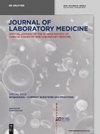样本处理对乳腺肿瘤患者白细胞介素-6稳定性的影响
IF 1.8
4区 医学
Q4 MEDICAL LABORATORY TECHNOLOGY
引用次数: 0
摘要
摘要目的探讨不同保存方法和工艺对血浆白细胞介素-6(IL-6)稳定性的影响。方法收集女性患者的肝素锂血浆:32例女性乳腺浸润性肿瘤患者和20例健康女性。每个样品被分成三个试管。样品储存在不同的温度或不同的时间。检测IL-6的浓度。结果与对照组相比,在4°C或25°C下储存12h后,患者的IL-6水平没有显著变化。然而,在25°C储存48h后,IL-6水平显著高于对照组(p<0.05)。乳腺肿瘤患者在4°C。乳腺肿瘤患者在25°C下仅储存2小时后,IL-6水平就比对照组增加了10倍以上。结论乳腺肿瘤样品中IL-6的浓度在不同的储存条件下有显著变化。血液样本处理程序的预处理需要标准化。IL-6水平的不同储存条件的比较可能不可靠。本文章由计算机程序翻译,如有差异,请以英文原文为准。
Effects of sample handling on the stability of interleukin-6 in patients with breast neoplasms
Abstract Objectives To investigate the influence of preservation methods and processes on the plasma interleukin-6 (IL-6) stability. Methods Lithium-heparin plasma was collected from female patients: 32 female patients with invasive breast neoplasms and 20 healthy females. Each sample was divided into three tubes. Samples were stored at different temperatures or at different times. The concentration of IL-6 was detected. Results IL-6 levels in patients were not altered significantly compared to the control group after storage at 4 °C or 25 °C for 12 h. However, IL-6 levels were significantly higher compared to controls (p<0.05) after storage at 25 °C for 48 h. IL-6 levels in patients with breast neoplasms were significantly higher compared to the control group (p<0.05) when stored at 4 °C after 12 h. IL-6 levels in patients with breast neoplasm increased more than 10-folds compared to the control group after only 2 h storage at 25 °C. Conclusions Concentrations of IL-6 in breast neoplasms samples significantly change under different storage conditions. Pretreatment needs to be standardized for blood sample handling procedure. Comparison of different storage conditions of IL-6 levels may not be reliable.
求助全文
通过发布文献求助,成功后即可免费获取论文全文。
去求助
来源期刊

Journal of Laboratory Medicine
Mathematics-Discrete Mathematics and Combinatorics
CiteScore
2.50
自引率
0.00%
发文量
39
审稿时长
10 weeks
期刊介绍:
The Journal of Laboratory Medicine (JLM) is a bi-monthly published journal that reports on the latest developments in laboratory medicine. Particular focus is placed on the diagnostic aspects of the clinical laboratory, although technical, regulatory, and educational topics are equally covered. The Journal specializes in the publication of high-standard, competent and timely review articles on clinical, methodological and pathogenic aspects of modern laboratory diagnostics. These reviews are critically reviewed by expert reviewers and JLM’s Associate Editors who are specialists in the various subdisciplines of laboratory medicine. In addition, JLM publishes original research articles, case reports, point/counterpoint articles and letters to the editor, all of which are peer reviewed by at least two experts in the field.
 求助内容:
求助内容: 应助结果提醒方式:
应助结果提醒方式:


